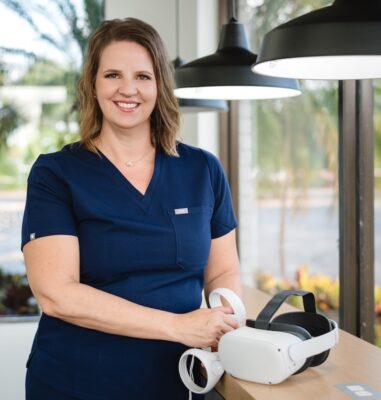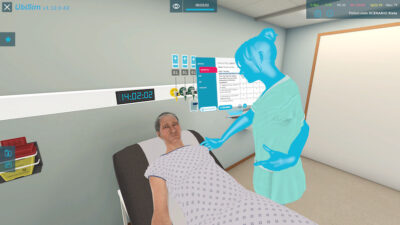How do you gauge if someone is dangerously anxious? In Canada, suicide rates among young girls have climbed to double that of boys. In the U.S., they’re at their highest point in 80 years, so that the U.S. Preventive Services Task Force now recommends routine anxiety screenings for children and adolescents as well as adults.
Every patient care interaction offers the potential to be a behavioral-mental health encounter, but not every health provider knows how to connect with patients and ask tough questions in a tactful way to get truthful answers. They may be reluctant to seem intrusive, especially with patients they rarely see. It’s hard enough to dig into a friend’s emotional state. Yet anxiety sufferers may avoid follow-up care if they perceive their healthcare providers as unsympathetic or dismissive.
Nurses on the frontline of patient care often do not feel adequately prepared to deal with “difficult” conversations due to a lack of education in effective communication skills, according to research into the role of empathy in healthcare. This lack of confidence can create additional stress in an already high-pressure role, and become a contributing factor to leaving the profession, with nearly a third of nurses in a recent McKinsey survey considering leaving their direct patient care role within a year.
Immersive virtual reality simulations curated for nursing education offer low-risk training opportunities for high-acuity communications that improve the nurse-patient relationship
Moreover, a shortage of clinical placements and preceptors for student supervision is also hindering many nurse learners from gaining exposure to the diverse array of human conditions and challenging conversations they need in order to reach comfort levels. A U.K. survey reported 70 per cent of early career and student nurses feeling they have missed vital learning experiences.
Assessing someone’s level of distress is not the only communication minefield for nurses to navigate. An equally fraught encounter is around end-of-life issues. Many nurse learners have never had direct exposure to death and are uneasy in conversations. They may fill pauses with unnecessary chatter, or be oblivious to appearing cold and uncaring if they remain silent. They may also unintentionally dredge up their own past or present grief while helping patients facing mortality.
The inability to have frank conversations around sensitive issues such as poverty, homelessness, physical safety, or other social determinants of health can also become an impediment to care. The quality and frequency of meals and the type of shelter may be directly connected to the patient’s complaint, but eliciting details can require tact and patience on the nurse’s part. Nurses who can better understand the backstory to a patient’s condition will be better equipped to offer solutions.
Filling the gap in clinical training sites
I taught students for a dozen years as a nurse educator. Providing a wide variety of safe and effective opportunities for practicing skills in high-acuity situations that can be difficult to predict or simulate is a huge challenge, especially when placements for clinical rotations are in tight supply.
Today, immersive virtual reality (VR) simulations are helping supplement instruction gained from in-person clinical rotations, as nursing colleges like the University of Manitoba and Ontario’s Sheridan College are experiencing. VR training platforms built specifically for nurses can offer learners the opportunity to gain practice in treating patients in an interactive and risk-free learning environment. VR scenarios can help nurse learners develop their clinical judgment and problem-solving capabilities by recognizing and analyzing cues, prioritizing hypotheses, generating solutions, taking action, and evaluating outcomes.
Interactive VR simulations are also transforming how nursing students learn to communicate with patients around anxiety, depression, self-harm, and other uncomfortable topics like drug use, end-of-life decisions, and stages of grief. As noted in a study published in 2021 in Nurse Education Today, highly realistic scenarios equip learners to provide compassionate, effective treatment while avoiding the limitations and risks associated with real-world – and scarce – clinical learning environments.
When I was a nursing student, I had clinical rotations in mental health yet lacked exposore to dealing with issues such as drug addiction, homelessness, and suicidal thoughts. As a graduate student, I found myself inadequately prepared to support patients grappling with these now prevalent societal challenges. I struggled to find the right words to use with patients, and hesitated to inquire about their emotional well-being, unsure of my place in doing so. And in dealing with mortality, I had to learn to tamp down the natural inclination to tell hurting people “it’s going to be okay,” which gives false hope, or “I understand,” which can imply agreement.
Gaining confidence through VR simulations
Through VR, nursing students can practice developing emotional intelligence and essential skills in empathy, communication, assessment, and intervention, both for evaluating care options and for delivering upsetting news about health status.
VR simulations can be customized to meet nursing curriculum and learning objectives with diverse patients across the lifespan with a wide array of conditions, from recognizing symptoms to selecting interventions and evaluating outcomes. VR encourages experimentation by allowing learners to hone soft communication skills – using verbal and non-verbal cues that convey empathy such as high-level listening, receptive body language, eye contact, honesty, clarity, and even purposeful silence – as well as hard skills like administering a Patient Health Questionnaire (PHQ-9) for depression screening, or the Generalized Anxiety Disorder (GAD-7) assessment, all in a safe and controlled environment.
For example, a nursing student may assess medication side effects for a child recently prescribed methylphenidate for treating ADHD and be required to tailor explanations to both the boy and his concerned mother. Other scenarios could require the nurse learner to evaluate and provide reassurance to a middle-aged man experiencing his first anxiety attack, or a young woman with worsening depression, or grief-stricken family members confronted with end-of-life decisions for a parent. Within the simulation, the patient and companions ask realistic and emotional questions, challenging the learner to build their communication skills.
A 2023 Pennsylvania College of Technology study looked specifically at how full immersion VR simulation can help nurses gain confidence in their communication skills and feel more comfortable in dealing with anxiety-prone patients and improve their own self-care techniques. Being able to review performance, receive real-time feedback on both wording and tone and delivery, and continue to practice is essential in building confidence for nurses to feel better prepared for therapeutic communications and, ultimately, avoid burnout.
Cultivating compassion through VR
Virtual reality is paving the way for more compassionate and patient-centered healthcare. New research out of Taiwan even concludes that virtual reality communication simulations “should be arranged as early as possible in fundamentals of nursing practice courses.”
Couldn’t we all benefit from improving our ability to navigate difficult conversations and become more confident in asking people about their feelings – and explaining our own? After nearly every incident of mass violence, we hear that the perpetrator exhibited warning signs of instability. Unfortunately, those in close proximity often lack the knowledge or skills to manage such indicators, while the sufferer may fear repercussions for seeking treatment.
Enhancing communication regarding anxiety, grief, and drug use could contribute to a better world, similar to how individuals acquire skills in cardiopulmonary resuscitation (CPR), the Heimlich maneuver, and administering naloxone for opioid overdoses. VR simulations offer this potential for no-risk practice in recognizing danger signals and facilitating open discussions about problems and issues – and revealing solutions.
Christine Vogel, MSN, RN, CHSE, CHSOS, is a lead nurse educator at UbiSim (www.ubisimvr.com), where she is actively engaged in designing, piloting, and evaluating evidence-based immersive virtual reality (VR) simulations for nurse learners. Her career spans more than 25 years in the field of nursing, including over 12 years of experience within nursing academia. She may be contacted via email at christine.vogel@ubisimvr.com.


![UbiSim-Nurses-Headsets-Educator-NHL[22]](https://hospitalnews.com/wp-content/uploads/2023/12/UbiSim-Nurses-Headsets-Educator-NHL22-e1704155732448-696x491.jpg)



